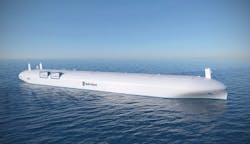Though maritime is a very old-fashioned industry, in the past 10 years or so, it has seen considerable rise in storable data points, lines of software code and software integration interfaces, noted Iiro Lindborg, general manager, remote and autonomous operations, ship intelligence, for Rolls-Royce Marine, which provides equipment and complex systems for offshore oil and gas rigs, and merchant and naval vessels.
“The number of systems and their data points is growing on vessels,” Lindborg said. “Systems are becoming more and more complex. Some players are ready for that complexity, some not.”
What Rolls-Royce is nearly ready for is to use all the data being gathered to let the ships drive themselves. The system provider aims to use data gathered as a baseline toward remote and autonomous operations, and expects to see at least some level of unmanned ships rolled out before the end of the decade. “It’s not if, but a matter of when,” Lindborg said.
Currently, data is used for R&D purposes to monitor vessel positioning, to understand better how different systems are used, and to gather information about environments, which can have a large effect on the end product.
Presenting at the Danfoss Drives Conference going on this week in New Orleans, Lindborg gave a nod to the data coming from the drives, including real values for active fault, motor speed, motor current, motor torque, motor power and motor voltage; and on/off signals for warning, failure, run, motor rotation direction, at reference and brake control status.
On a pilot project called Far Scorpion, about 15 GB of data is logged every day, most of it sent to shore for inspection and to build an empirical log of environmental conditions, types of operations, usage and performance. “It’s a very expensive exercise,” Lindborg noted. “We only get the data we need.”
What data is needed might be up for debate, since “everyone wants to do it; nobody wants to pay for it,” Lindborg pointed out. Nonetheless, Rolls-Royce is able to the use the data itself to better understand how the equipment is working and its operation profile.
Today, data is used to help a vessel with things like navigation and station keeping, decision support, real-time optimization, health monitoring and automated reporting. “There are many different things already telling us what to do,” Lindborg said. “So the next step will be doing it itself.”
There are some key development areas that will help prepare unmanned vessels for readiness, including remote control centers, cybersecurity, communications, situational awareness systems and remote controlled systems.
Like other industries, cybersecurity is “a hot potato in marine as well,” Lindborg said. But Rolls-Royce is able to apply its experience from the aerospace industry, where it has long been monitoring engines in real time.
Lindborg lamented the lack of situational awareness in the marine industry today, where they are typically not making use of even basic technology advancements. “Vessels are very stupid, and the operators are even more stupid,” he said. “In pitch black seas, operators look out the window with binoculars.”
Remote controlled systems are also not where they need to be. “Almost none of the equipment on board today can be remotely controlled today,” Lindborg said. “It’s too complex.”
Lindborg also called for improvements from the drives industry to help clear the way for unmanned operations. Drives need to become more predictable, he said. But for the systems to be predictable, they need to be standardized. And to be standardized, they first need to be simplified. “We’ve spent the last 20 years creating complex systems that we don’t even understand ourselves how they work,” he said.
Other drive advances needed include clear boundaries (what is the role of the drive and what is not); systems with artificial intelligence, including self-learning, self-healing (some are already in place today) and post-mortem playback capabilities; and data processing at the lower levels.
Nevertheless, Lindborg contends that the technology isn’t as difficult a roadblock as labor unions or current legal standings. At this point, an unmanned vessel is legally considered “debris.” And shipping companies working with Rolls-Royce on the concept do not want to be publicly named because they know they will have unions on their backs. They fully expect there to be strikes once the programs are announced.
But Lindborg still reiterated his claim for unmanned vessels by the end of the decade. Perhaps not autonomous yet at that point, but at least remotely controlled.
About the Author
Aaron Hand
Editor-in-Chief, ProFood World

Leaders relevant to this article:
